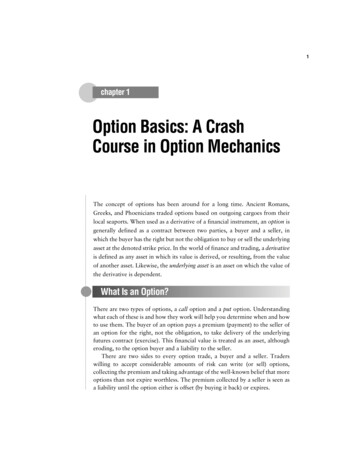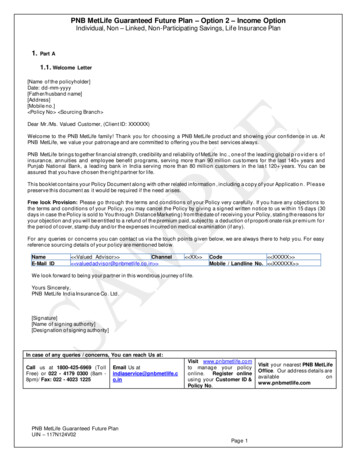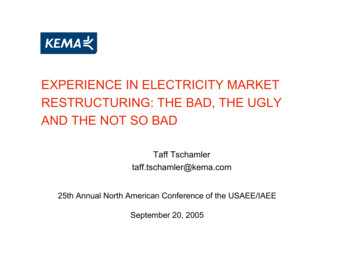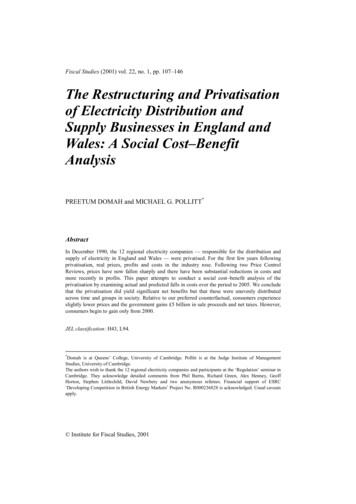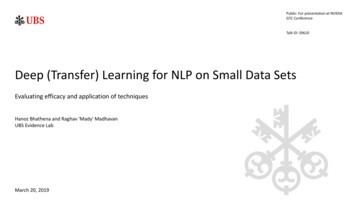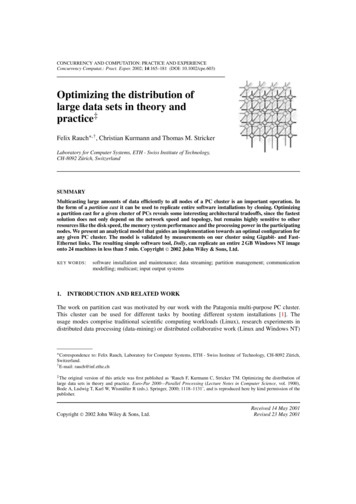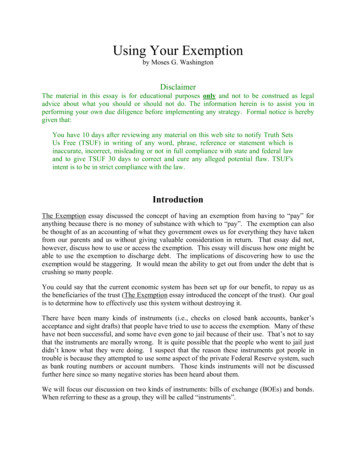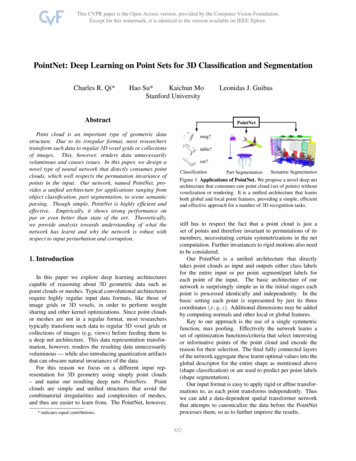
Transcription
Restructuring Option Chain Data Sets Using MatlabA Directed Research ProjectSubmitted to the Faculty of theWORCESTER POLYTECHNIC INSTITUTEIn partial fulfillment of the requirements for theProfessional Degree of Master of ScienceinFinancial MathematicsbyAlison BakerMay 2010Approved:Professor Marcel Blais, AdvisorProfessor Bogdan Vernescu, Head of Department
AbstractLarge data sets are required to store all of the information contained in option chains.The data set we work with includes all U.S. exchange traded put and call options. This data setis part of a larger data set commonly referred to as the National Best Bid Offer (NBBO) data set.The national bid best offer is a Securities and Exchange Commission (SEC) term for the bestavailable ask price and bid price. Brokers must guarantee investors these prices on their trades.We have acquired data for the 5 year period from 2005 to 2009 for all U.S. tradedoptions. Each year of data is approximately 6 gigabytes. The company, (DeltaNeutral - OptionsData And End Of Day Downloads, 2010), from which we acquired the data, also has a softwarepackage, OptimalTrader, to process the data. For this data to be used in research projects, thedata must be accessible by specific underlying security for selected date ranges. This type ofdata is more useful to the financial mathematics student than the output given by the softwareprovided by DeltaNeutral.The software used in this data manipulation is Matlab. Each individual file of originaldata was parsed, and new files were written with some reformatting in which the original datawas largely reorganized. The new organization will make searching for information from onestock or any specific group of stocks easier to achieve. We have created 3 m-files in Matlabwhich deal with reformatting the data, error handling, and searching through the original orreformatted data. The result is that new datasets can be created for further studying andmanipulation. Future students working with this data should find this method, toolset, and thenewly constructed datasets to be useful tools in working with options data and examining optionchains.2
AcknowledgementsI would like to thank my advisor, Professor Marcel Blais, for his guidance,encouragement, support, and most of all for his patience throughout this process. Thanks toAdriana Hera, for her generous Matlab insight. And last but not least, thanks to my friends andfamily for their emotional support over the past 2 years.3
Table of ContentsContents1. Introduction . 52. Data . 72.1 Structure.72.2 Variable Explanation .93. Our Approach . 113.1 Matlab Scripts .113.2 Creating New Data Sets .113.3 Dataset Parsing.133.4 Writing New Files .144. Error Handling. 155. Data Processing Challenges . 176. How To Use. 187. Conclusion . 25A. Appendix . 27A.1 formatDateToTicker.m .27A.2 deleteAday.m .29A.3 Option Extension Codes.30A.4 Exchange Variable .32B. Bibliography . 334
1. IntroductionWe have acquired 5 years of options data from DeltaNeutral (DeltaNeutral - OptionsData And End Of Day Downloads, 2010). The data is organized by date, where each fileincludes one full day of all put and call options trading on exchanges in the U.S. This data isreferred to as the National Best Bid Offer (NBBO) data set. The national bid best offer is aSecurities and Exchange Commission (SEC) term for the best available ask price and bid price.Brokers must guarantee investors these prices on their trades. DeltaNeutral also uses the BlackScholes model to calculate the Greeks, (beta, gamma, theta, and vega), and the implied volatility,and includes them in this data set. The Fed Funds Rate is used as the risk free rate in thesecalculations. Dividends are not considered. In all, the data set from DeltaNeutral isapproximately 30 gigabytes of data.This project’s first aim is to create a new data set which will be formatted and organizedin a way which is more suitable for financial mathematics students to use for options analysisand mathematical modeling. Along with creating a new data set, we have also created a templatefor searching the data and creating specialized file sets.The main change in the data from its original format to the new format is separationbetween organization in files by date to organization in files by stock symbol (ticker), and withinthese files, by date. Also, the strings that are the expiry and data day need to be changed tonumbers to allow for calculations involving time change.The first step is to successfully read through each original file by date, in chronologicalorder, one file at a time. The data is systematically written to new files arranged by their tickers.Data from each date thereafter is appended to rest of the data in each symbol file.5
The try / catch function is used in order to find any problems in writing the new files.One problem found was that the symbol included a '/' character which cannot be used within afilename to save to the same folder. The '/' is now automatically changed to a ‘1’, which willcause no problems with writing files.Since we are parsing 30 gigabytes of data, a failsafe was created to erase a whole dataday from all of the newly created files. This uses a variable created while the files are beingwritten, which stores the latest data day being processed. This data day is then used in thedeleteAday script which will read the symbol files, delete any data from that data day in theoutput files and rewrite the output files without that information. The original script can then berestarted from that day without causing a repeat in any information already written to the newfiles.The software used in this data manipulation is Matlab. Each individual file of originaldata was parsed, and new files were written with some reformatting in which the original datawas largely reorganized. The new organization will make searching for information from onestock or any specific group of stocks easier to achieve.6
2. Data2.1 StructureThe original data set, provided by DeltaNeutral (DeltaNeutral - Options Data And End OfDay Downloads, 2010), is comprised of 5 years of options data, from 2005 through 2009,consisting of all U.S. traded options, using NBBO data. A list of exchanges can be obtainedfrom the SEC’s website. (Exchanges, 2010)Some of the options exchanges are: The Chicago Board Options Exchange (CBOE) BATS Options, New York Stock Exchange ( including NYSE Arca, NYSE AlternextUS), Philadelphia Stock Exchange (PHLX), now known as NASDAQ OMX PHLX International Securities Exchange Holdings, Inc The Chicago Mercantile Exchange (CME) The Chicago Board of Trade (CBOT) Boston Options Exchange (BOX)Each of the 5 years of data is stored in a separate folder. Each year has one file of data pertrading day. All of this data is stored in one folder labeled byDate. Each day of data (eachoriginal file) is structured as follows: Data is in comma separated values, csv, format. This means that each line, or row, of thefile has information in it, each piece of information separated by a comma. Each row is an observation of one available option.7
Within each line of data (row in the file), the information contained looks like this:A,16.24,*,A,AR,call,01/16/2009,01/02/2009 04:00:00 2,0.2128DeltaNeutral (DeltaNeutral - Options Data And End Of Day Downloads, 2010) describesthe data per line with these names:UnderlyingSymbol, UnderlyingPrice, Exchange, OptionRoot, OptionExt, Type, Expiration,DataDate, Strike, Last, Bid, Ask, Volume, OpenInterest, IV, Delta, Gamma, Theta, Vega8
2.2 Variable ExplanationMatlab variablenameMatlabVariableTypetickers (used forfile names)uS (uniquesymbol) used forfile 0:00 riable NameUnderlyingSymbolDescriptionThis is the stock symbol orticker.TypeExpirationPrice of the underlying onday of observationData is from all USexchangesThe option’s symbolContains information aboutexpiry, strike, and type of theoption (described further inappendix)put or callexpiration dayDataDateobservation dayStrikestrike priceprice at which option was lasttraded atprice buyer is willing to payprice seller is willing toacceptnumber of transactions filedfor that daynumber of open stock optionspositionsimplied volatility(calculated using BlackScholes algorithm and FedFunds tBidAskVolumeOpenInterestIVExampleA9
Where (in the Greeks):V is value of the option.S is stock price.T is time to expiry.σ is volatility of the underlying.Tables for explanation of option symbols, roots, and extensions are included in theappendix. There has been a change in the meaning of the “exchange” variable in DeltaNeutral’sdata sets. The new meaning of the data in this variable is explained in a file from DeltaNeutralwhich is included in Appendix A.4.10
3. Our Approach3.1 Matlab ScriptsThe use of Matlab scripts makes the type of calculation (dataset manipulation) easy tohandle for several reasons.The first is that there are no inputs or outputs. We do not need to enter any informationand we do not want any returned. The purpose of this project is to create software formanipulation of datasets, formatting, deleting information, and searching within files for specificlines of data thus there is no need for output. Within the scripts are functions for creating newfolders and writing files within these folders. This makes a convenient, compact set ofinformation for the user to then perform data analysis Matlab or another programming language.3.2 Creating New Data SetsThe first script, formatDateToTicker, is not intended to be changed (or even used) by theuser. This file is used only to create an entire new data set from the original, producing a newdata set with a different format.The structure of the data set is largely similar to the original set, but there is reformattingand significant rearrangement of the data. The first step in this script is to successfully readthrough each original file, one by one, in chronological order.The original files are named as ‘options yearmonthday.csv’, where year is a 4 digit year(e.g. 2005), month is 2 digits (e.g. 02), and day is 2 digits (e.g. 15). The first file inchronological order is options 20050102.csv. The new files that are being created from the11
original data are files containing only information about one underlying symbol. The data inthese new files should be arranged in chronological order, therefore the original files need to beread in chronological order and data from each sequential file appended to the proper previousdate’s information.Example of data from an original 8/20051/3/2005 16:00 1/3/2005 16:00 1/3/2005 16:00 1/3/2005 16:00 Example of data from a new file:AAA2.39E 01 *2.39E 01 *2.39E 01 *OAE MGOAE AHOAE MHputcallput733061733061733061732315.7 732315.7 732315.7 The original file’s data is saved as a variable, C, which is then parsed, reformatted, andallocated to new files. In all, there are several hundred thousand lines in each date file, includingdata for approximately 3,000 unique underlying symbols.The underlying symbols included in date files change through time. New companies maybe formed or go public and options will begin to be sold on the underlying for that company.Others may dissolve, and options will no longer be traded on their stock. In the end there areapproximately 3200 new files, one for each underlying symbol throughout the 5 years of databetween the years 2005 and 2009.12
3.3 Dataset ParsingAs mentioned above, each date
The first step is to successfully read through each original file by date, in chronological order, one file at a time. The data is systematically written to new files arranged by their tickers. Data from each date thereafter is appended to rest of the data in each symbol file.
